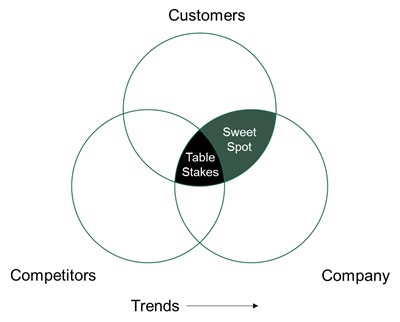If you’re trying to grow a business, you know that it’s important to understand the market. Actually doing this might seem difficult, even overwhelming—but it doesn’t have to be.
Over the past few posts, I’ve given you a step-by-step guide for making sense of each part of your market ecosystem: your company, your customers, and your competitors. It all starts with the 3C Needs Map, which shows how these three entities intersect.
We explained what each area of the map means, from the “table stakes” in the center to your “sweet spot” on the edge. We discussed how to use a Customer Compass to determine what customers are right for you and a list of targeted interview questions to figure out what your customers want.
Now, it’s time to examine the final piece of the 3C Needs Map puzzle: your competitors.
Looking at the big picture
Some companies are overly self-centered. They focus only on their own capabilities and don’t stop to question how they measure up to their competitors.
But this is a mistake. Fortunately, it’s easy to gather information about your competitors and use it to make business decisions. All it takes is a little research.
If you’ve ever read Consumer Reports, you probably recognize the charts they use to display features of competitors in a given market. Shaded circles represent different levels of competency on a particular feature, making these charts very easy to scan and interpret.
You can do the same thing with information about your own market. Simply choose the factors that are relevant in your industry based on your customer interviews. Then, score your company and each of your competitors on each criterion.
Don’t have this information on every one of your competitors? There are multiple ways you can get it. For example, you can use:
· Your sales team. Often, they know your competitors better than anyone else in your company.
· Competitors’ websites and social media profiles. Learning how your competitors describe themselves can bring valuable insights.
· Trade associations. These are a good way to network—and also learn about your competition.
· Customer interviews. Your customers are often willing to give firsthand, candid information about what your competitors are like to work with.
· Paid data services. Services like Hoovers, Ibis, and LexisNexis can give you the competitor insights you need for a fee.
Gather all of the information you can find, then fill out a Competitor Comparison Chart using the factors that are relevant in your industry. After scoring your company and competitors, you should look across the rows and classify the competitive position in one of three categories:
· Table stakes. Many companies score well against customer needs and no one has a clear advantage.
· Company “sweet spot.” Your company exceeds competition.
· Competitor “sweet spot.” Your competitors exceed your ability to deliver on customer needs
This will help you clarify and even redefine what is considered “table stakes” in your market—and what features make you unique.
Once you understand your strengths, you can play to them. Make your differentiators a key part of the story you tell your customers on sales visits and in your marketing materials.
You’ll want to refresh this chart periodically, as your and your competitors’ offerings are likely to shift over time. Depending on how quickly things change in your industry, you should plan to reevaluate your standing roughly every 2 years.
Bringing it all together
Now, you have a complete toolkit for understanding your market:
· A Customer Compass for determining your company’s best-fit customers
· Interview questions for learning your customer needs
· A Competitor Comparison Chart to visualize what your competitors offer
With these three tools, you should be able to fill in the 3C Needs Map—not with a hunch or a best guess, but with reliable data and insights. The filled-in map can help you make decisions about how to position your company, satisfy your customers, and grow your business. Once you start using these tools, you might wonder how you ever did without them.



